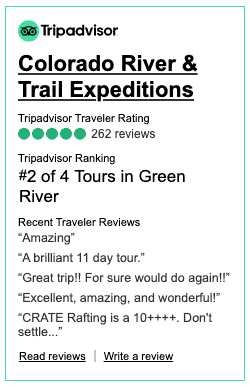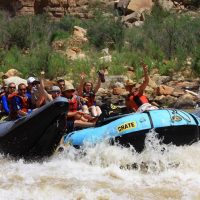Preparing For Your Trip
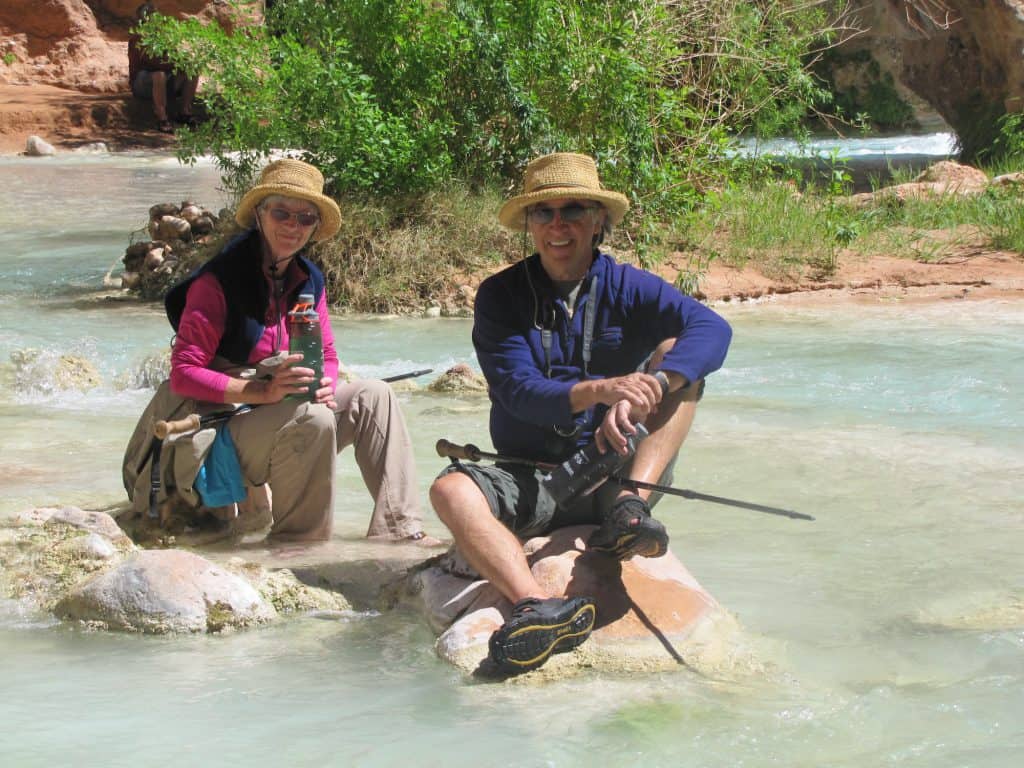
Preparing for Your Trip
“The mark of a successful man is one that has spent an entire day on the bank of a river without feeling guilty about it.” – Chinese Philosopher
Why Choose CRATE?
- Under Original Ownership Since 1971
- 5 Star Rated Rafting Trips
- We Provide Everything You Need For a Great Rafting Trip
About the Experience

The CRATE crew is very knowledgeable and shared their passion and love for the river and environment. The food was excellent and plentiful, and they try very hard to ensure that everyone had a great trip.
The weather conditions can change quickly in the canyon in August: 100 degrees to a hail storm. Their "pack list" is very good. Bring a good hat, sunscreen, and clothes that can get wet and dry QUICKLY, a good pair of HIKING water shoes, rain gear, head-lamp. Pack that sweatshirt they recommend, I used it several time to warm-up off the river. I enjoyed having a pillow and sheet.
Strongly recommend CRATE, our guides were wonderful.
I will never forget this trip, I would recommend it to everyone.
Book Your Adventure Today!
(800) 253-7328
Home » Preparing For Your Trip
River Trip Packing Tips
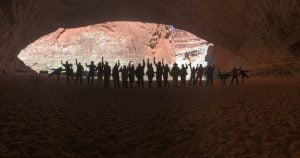 Packing for a river trip can be overwhelming, but it can be less stressful with a few helpful tips. When we confirm your reservation, we will send you a trip planning booklet complete with a packing list. It is important to review your trip planning information and follow your packing list. You want to have enough gear to make your trip comfortable, but you do not want to over pack. Each night spent along the river, you will be responsible for carrying your personal gear from the raft to your campsite. If you overpack, your bag will be heavier to move. It is also time-consuming digging through, unpacking and repacking extra gear. Here are a few tips for packing your river bag.
Packing for a river trip can be overwhelming, but it can be less stressful with a few helpful tips. When we confirm your reservation, we will send you a trip planning booklet complete with a packing list. It is important to review your trip planning information and follow your packing list. You want to have enough gear to make your trip comfortable, but you do not want to over pack. Each night spent along the river, you will be responsible for carrying your personal gear from the raft to your campsite. If you overpack, your bag will be heavier to move. It is also time-consuming digging through, unpacking and repacking extra gear. Here are a few tips for packing your river bag.
- Put small items like socks and underwear in a mesh bag, ziplock bag, or packing cubes. This will make it easier to find them in your river bag.
- Roll shorts and shirts together in outfits. If you are packing two shirts to each short, roll them both together and then put the second shirt at the top of your bag for the next day.
- Put extra items at the bottom of your bag. This could include extra layers or jackets, shoes and things you won’t need until the end of your trip.
- Have your rain gear at the top of your bag or in your day bag. You might not think you will need rain gear in the middle of the summer, but running rapids first thing in the morning or in the evening shade of the canyon can be cold. You may want to slip on your rain gear for these occasions. Rainstorms can also come on quickly, so knowing where your rain gear is can help you find it quickly to stay dry.
- Having a garbage bag to separate your dirty and sometimes wet laundry from the clean dry clothes in your bag is a good idea. It is also nice to have a few extra ziplock bags. They come in handy!
- Bring a couple small, locking carabiners. They are really useful for attaching your day bag, water bottle and other items to the boat.
- One outfit to wear in camp. This could even be a cotton t-shirt and shorts. It might feel good to have something comfortable to wear around camp.
- Wet wipes are nice to have for a quick wipe down before bed or after blowing sand. It feels great to clean the sand off your face and out of your ears!
Health & Physical Requirements
People of all ages have enjoyed this river trip with us. Our major concern is that participants be in good health and good physical and mental condition. We do not recommend this trip for those with chronic heart trouble, back pain, severe arthritis, or for anyone recuperating from recent surgery. Pregnant women should check with their physicians. Factors such as age, weight, lack of conditioning, heart or other chronic diseases, may be exacerbated due to the unique environmental conditions and physical challenges of a rafting adventure. With this in mind, please let us know if you have any health conditions of which we should be aware.
Essential Eligibility Criteria for Rafting Trips in Grand Canyon:
- Be able to wear & properly fasten Type V Life Jacket provided by CRATE (max. chest size 58”)
- Be able to get on and off the boat multiple times each day
- Be able to hold on to ropes, handholds, and safety lines aboard the raft
- Be able to assist in self rescue in case of falling overboard, such as swim to the raft and/or catch and hold on to a thrown safety rope.
- Be able to carry personal gear on and off the boat and to/from the campsite
- Be able to set up personal campsite (tent, camping gear, etc.)
- Be able to walk over sand, rocks, unimproved trails and other uneven terrain
- Be able to withstand extended environmental elements, including exposure to extreme heat, cold, wind, and rain.
Camping & Off River Hiking
Camping and off-river hiking during a whitewater rafting trip can be physically and mentally demanding, as they require participants to navigate rugged terrain and sometimes remote wilderness areas. Here are some of the rigors and challenges you may encounter:
Physical Endurance: Off-river hiking often involves navigating through challenging terrain, which can include sandy beaches, uneven surfaces, rocky areas, and through side streams.
Self-Sufficiency: During camping, you’ll need to be self-sufficient in terms of setting up your own camp, carrying your bags to/from the boat, etc.
Weather Extremes: The weather can be unpredictable in wilderness areas, and you may face extreme temperature fluctuations, exposure to harsh sunlight, or sudden rain showers. Being prepared with appropriate clothing and gear is essential.
Safety Concerns: In remote wilderness, access to medical help can be limited. Participants should be aware of potential risks and practice safety precautions, including staying together as a group and following safety guidelines.
Despite these rigors, camping and off-river hiking offer a chance to connect deeply with nature, experience the beauty of remote landscapes, and enjoy a sense of self-sufficiency and adventure. Proper preparation, adherence to safety guidelines, and a spirit of exploration can lead to a fulfilling and enriching outdoor experience during your whitewater rafting trip.
Environmental Considerations
CLIMATE CONDITIONS
It is important for everyone to stay healthy and comfortable while on their whitewater rafting trip. The desert climate can be rigorous due to its extreme temperatures, dehydration risks, and the physical and psychological demands of the challenging terrain. You should prioritize hydration by drinking plenty of water throughout the day, wear lightweight, sun-protective clothing to shield yourself from the intense sun, and apply sunscreen generously and often. Additionally, be mindful of heat-related illnesses and take frequent breaks in the shade to cool down, especially during the hottest parts of the day. Proper headwear, like wide-brimmed hats, and sunglasses can also help protect against sunburn and eye strain, ensuring a more enjoyable rafting experience.
If you are able to acclimate to hot weather in advance of your trip, we suggest that you do so. Acclimating to hot weather requires a gradual adjustment of your body to higher temperatures. Start by spending short periods of time outdoors. As your tolerance builds, extend your outdoor activities gradually. Pay attention to your body’s signals, and if you start feeling dizzy or overly fatigued, take a break in a cooler environment. Make sure to stay hydrated and wear appropriate clothing. With time and patience, your body will adapt to the heat, making it easier to cope with hot weather conditions and reduce the risk of heat-related illnesses.
Below are some common heat-related illnesses that you should be aware of that could occur during your whitewater rafting trip.
HEAT EXHAUSTION: Is the result of dehydration due to intense sweating. Hikers can lose one or two quarts (liters) of water per hour. Symptoms are pale face, nausea, cool and moist skin, headache, and cramps. To treat, drink water, eat high-energy foods, rest in the shade, and cool the body.
HEATSTROKE: Is a life-threatening emergency where the body’s heat regulating mechanisms become overwhelmed by a combination of internal heat production and environmental demands. Symptoms include flushed face, dry skin, weak and rapid pulse, high body temperature, poor judgment or inability to cope, and unconsciousness. The heatstroke victim must be cooled immediately! Continuously pour water on the victim’s head and torso, fan to create an evaporative cooling effect, move the victim to shade, and remove excess clothing. The victim needs evacuation to a hospital. Someone should go for help while attempts to cool the victim continue.
HYPONATREMIA (water intoxication): Is an illness that mimics the early symptoms of heat exhaustion. It is the result of low sodium in the blood caused by drinking too much water, not eating enough salty foods, and losing salt through sweating. Symptoms are nausea, vomiting, altered mental states, and frequent urination. To treat, have the victim eat salty foods. If mental alertness decreases, seek immediate help!
HYPOTHERMIA: Is life-threatening emergency that can occur in any season. The body cannot keep itself warm, due to exhaustion and exposure to cold, wet, windy weather. Symptoms are uncontrolled shivering, poor muscle control, and careless attitude. To treat, put on dry clothing, drink warm liquids, warm victim by body contact with another person, protect from wind, rain, and cold.
PREPARING FOR YOUR TRIP
As you prepare for your upcoming river rafting trip, we want to emphasize the crucial importance of proper nutrition and hydration during your adventure. Rafting can be physically demanding, and being out in the sun can lead to increased fluid loss and energy expenditure. To ensure your safety, comfort, and enjoyment, it’s essential to eat and drink properly and regularly.
Hydration is key: The river environment, coupled with physical activity, can quickly lead to dehydration. Drink often and throughout the day. Our guides will provide safe drinking water and also offer Gatorade or Lemonade for electrolytes. Staying hydrated not only supports your overall well-being but also helps combat fatigue and heat-related issues.
Fuel your body: Eating balanced meals and snacks is equally vital. At meals, enjoy hearty, nourishing options from our provided meals. If at any time you are hungry during the day, don’t hesitate to ask your rafting guide(s) for a snack. A rafting trip is not the time to skip a meal or go on a diet.
Remember, maintaining proper nutrition and hydration enhances your experience, ensuring you have the energy and vitality to fully appreciate the beauty of your surroundings and the excitement of the river. Our guides are always available to offer tips and assistance in this regard.
Rafting Trip Recommendations
Spring Hiking & Rafting Special
The focus is on off-river hiking and exploration.
Our classic Grand Canyon rafting expedition. It offers ample time to see the sites and side canyons.

3 Day Motor Expedition
Grand Canyon Rafting combined with a stay at the Bar 10 Ranch.
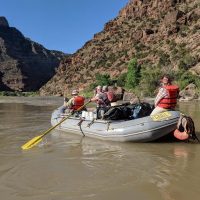
The best multi-generational rafting trip you could find! Paddle your own inflatable kayak through over 30 fun rapids, or just sit back and relax.
Home » Preparing For Your Trip
CRATE Rafting Trips Since 1971
Free PDF copy of our Rafting Brochure!

